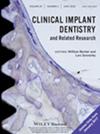Digital workflow for graft harvest and positioning in deficient anterior mandibles versus conventional technique: Randomized controlled trial
Abstract
Background
The cortical shell technique is frequently associated with technical drawbacks, such as the lack of anatomical guidance during shell harvest and graft. This study aims to assess the horizontal bone gain and accuracy of a digitalized protocol that incorporates two interlocking patient-specific stackable guides (PSSGs) to control the shell harvest, positioning, and fixation.
Patients and Methods
Twenty patients with deficient anterior mandibles were randomly allocated; 10 patients received freehand symphyseal shell harvest and fixation (the control group), whereas the other 10 received fully guided harvest and graft (study group) using (PSSGs), the first aided an accurate shell harvest, whereas the second conveyed shell fixation. The interposition gap among both groups was loaded with an equal mix of xenogeneic and autogenous particulates. The mean radiographic bone gain among both groups was calibrated 6 months postoperatively, and the accuracy of the digital plan was assessed by superimposing and comparing the virtually planned horizontal bone dimensions with the immediate postoperative actual bone dimensions.
Results
The mean 6-month postoperative horizontal bone gain value of the study group was recorded as (4.97 ± 0.73) mm versus (4.45 ± 0.61) mm for the control group, with a statistically insignificant mean gain difference of (0.52) mm, (p = 0.101). The mean virtual preplanned horizontal bone gain was recorded (5.4 ± 0.6) versus (5.4 ± 0.6) for the immediate postoperative actual bone gain, which was also statistically insignificant (p = 0.9).
Conclusion
The (PSSGs) provided a precise method for graft harvest, position, and fixation, resulting in satisfactory alveolar ridge dimensions with intimate accuracy.

 求助内容:
求助内容: 应助结果提醒方式:
应助结果提醒方式:


